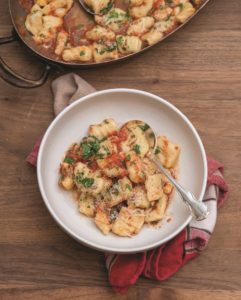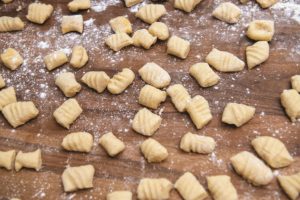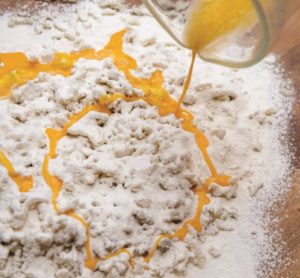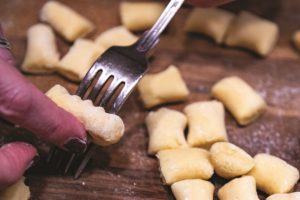January’s sun sets smack down in the center of Blackfish Creek tinting the clouds beyond my back window a cotton-candy pastel. It’s stop-in-your-tracks gorgeous Cape Cod light. And every bit of it is gone by 4:30 p.m.
I remind myself this means there is more time for making things. Friends stitch quilts, mold clay, or steep perfumes. I knead, sear, and braise. It might be too early for dinner when night falls in the late afternoon, but it’s not too early to get cooking.

With summer’s bonanza of sweet tomatoes, peaches, and corn, it’s best to get out of their way. But winter cooking is different. Now, when humble root vegetables and pantry ingredients are what we have to work with, it’s more about process and transformation.
I can mark the years by certain winter passion projects. There was the English muffin year and pozole before that. This is the year of the gnocchi.
There are two kinds of these Italian potato dumplings. The shelf-stable store-bought ones are a little dense, but tossed into a creamy sauce with cheese or a meaty ragu they make for comforting no-effort meals. But homemade gnocchi are a whole different thing, defined by their pillowy lightness. For many cooks they are a kind of holy grail — they are simple, but it takes a certain touch to get them right.
My gnocchi journey took me down the YouTube rabbit hole of the Pasta Grannies — British food writer Vicki Bennison’s wonderful collection of videos of Italian Nonnas making traditional pastas, gnocchi, and pizzas. Their stories and recipes can now be found in cookbooks, but I am not sure the page can capture the alacrity of 101-year-old Rosina sharpening a foot long knife or rolling pasta out by hand. Watching these women cook defines “practice makes perfect.”
Sometimes it seems the fewer ingredients in a dish, the more temperamental it can be. That’s definitely the case with gnocchi. The classic recipe includes nothing but potatoes, just enough flour to bind them, and salt. What’s hard is getting the flour-to-potato ratio right. Too much flour and they’ll turn out leaden, too little and they’ll fall apart when you boil them.

Part of the problem is that the moisture content of potatoes varies, affecting the amount of flour needed for the dough. That’s why I suggest a range on the quantity of flour in this recipe. It’s why being present in the process matters. And why, over time, as you become more confident, you’ll use less flour.
Starchy russet potatoes are best and baking them means they won’t get waterlogged. Purists cluck about adding eggs, but I like them because they make the dough more forgiving and because our local eggs add a sunny color. Maybe by the end of this winter of gnocchi practice I will be ready to leave out the egg.
My husband Robert makes an intensely delicious pure tomato sauce — preserving is his thing. Tossing my winter gnocchi with his summer sauce is the perfect marriage of the seasons, keeping us cozy on these long winter nights.
Classic Gnocchi
Serves 2 to 4
For the gnocchi:
2 pounds russet potatoes (3 to 4), scrubbed
1 ½ to 1 ¾ cups all-purpose flour
¾ tsp. fine salt, plus more for the cooking water
A pinch of freshly grated nutmeg, optional
1 large egg, beaten
For serving:
1 ½ cups tomato sauce
3-4 Tbsp. unsalted butter
1/4 cup chopped flat-leaf parsley
1/3 cup freshly grated Parmigiana-Reggiano or Pecorino or a combination
Freshly cracked black pepper
- Heat oven to 425° F. Prick the potatoes 4 or 5 times and place them, evenly spaced, on a rack set over a baking sheet. Bake until fork tender, about 40 to 50 minutes depending on their size.
- Sift about ¼ cup of the flour onto a clean countertop. Split the hot potatoes lengthwise. Holding a hot potato in a towel or oven mitt, scoop the flesh into a ricer or food mill. Press it over the flour, and continue with the other potatoes, moving the ricer so the potatoes fall in an even, broad circle on the counter. Spreading out the potatoes allows them to release their steam and stay dry — you don’t want their moisture trapped in the mound of spuds. (Discard or repurpose the skins.) Season the potatoes with salt and the pinch of nutmeg, if using.

An egg makes the dough more forgiving and gives it a sunny hue. - Sift about 2/3 cup flour over the potatoes then drizzle the egg evenly on top. Using a bench scraper or metal spatula, lightly chop the egg into the mixture. Continue chopping to evenly mix flour and potato. Dust with a bit more flour if needed and then flatten and fold the mixture together, about 4 to 6 times, adding only as much flour as needed to make it hold together as a dough. You are looking for a balance here, working the dough just enough to bring together. Avoid kneading it like bread dough, which would make the gnocchi dense and tough. The dough should feel like a soft pizza dough — or your earlobe. When the dough feels right, form it into a loaf and divide it into 6 even pieces. Cover them with a towel to keep them from drying out.
- Clean your hands and the work surface. Use your hands to roll a section of dough back and forth over the counter into a 1/2 -inch wide “rope,” dusting your hands lightly with flour as needed to prevent sticking. Repeat with the remaining pieces of dough. Cut each rope of dough crosswise into 3/4-inch-long gnocchi.

Marking the gnocchi with the back of a fork.
- If you want to make the traditional ridges in the gnocchi, dip a fork in flour and hold it tines down and curved side up. Using your index finger gently press the gnocchi into the back of the fork to make the ridges and then flick the gnocchi off the fork. If needed, pinch the ends to make a plump nugget. Evenly space the gnocchi on a lined baking sheet. Refrigerate if not cooking right away. You can also freeze the gnocchi until firm, then transfer them to a container and keep frozen for up to a month.
- Warm the tomato sauce with the butter over medium heat in a casserole dish while you bring a large pot of generously salted water to a bubbly boil. Slip the gnocchi into the water; they will drop to the bottom. Give a light stir to prevent sticking and continue to boil until the gnocchi float to the surface, about 1 minute. Once they come to the surface, cook the gnocchi for 30 seconds to a minute more. (Taste to make sure they aren’t floury.) Use a slotted spoon or strainer to scoop the gnocchi into the warm sauce and give the dish a shake so the gnocchi rests in a single layer. Add the parsley, cheese, and fresh pepper, and serve immediately.



